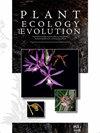New and little-known species of Englerodendron (Leguminosae-Detarioideae) from Central Africa, with a revised key to the genus
IF 1.1
4区 生物学
Q3 PLANT SCIENCES
引用次数: 0
Abstract
Background and aims – The genus Englerodendron (Leguminosae-Detarioideae) has recently been enlarged to include Isomacrolobium and Pseudomacrolobium, and currently includes 18 tropical African species. The recent discovery of a new species in Gabon has led us to re-evaluate the delimitation of several taxa in the genus.Material and methods – This paper is based on field work by the authors in Gabon, and on a study of herbarium material from BR, BRLU, K, LBV, MO, P, and WAG; normal practices of herbarium taxonomy have been applied.Results – Englerodendron nguemae is described and illustrated as a new species, endemic to Gabon. It is remarkable for the variation in its leaves, which may be 2-jugate, 1-jugate, or unifoliolate on the same plant. The species is most similar to E. brachyrhachis, but the latter has uniformly 2-jugate leaves; E. nguemae also differs in its longer and more broadly winged leaf rachis (if present) that is convex (not flat) above, its stamen filaments pubescent at the base, and its glabrous style. Several collections from the Democratic Republic of the Congo, previously associated with E. obanense, are considered here to represent two different taxa. One of them, E. macranthum (a new combination and name at new rank based on Macrolobium isopetalum var. macranthum, which is raised to species status), is endemic to the Mayombe range and differs from E. obanense by its inflorescences branched from the base or nearly so, and its shorter 1-seeded pods. The other taxon, still imperfectly known and here treated as Englerodendron sp. A, is endemic to the Kivu region; it differs from E. obanense by its large foliaceous stipules and from E. conchyliophorum by the lack of a basal auricle on the stipules. In addition, the first records of E. leptorrhachis from Equatorial Guinea, and of E. conchyliophorum from the Republic of the Congo, are documented, and a revised key to the now 21 species (one undescribed) of Englerodendron is presented.中非Englerodendron(豆科Detarioideae)的一个新的和鲜为人知的物种,以及该属的一个修订的键
背景和目的-Englerodendron属(豆科Detarioideae)最近被扩大到包括异巨球藻和假巨球藻,目前包括18个热带非洲物种。最近在加蓬发现了一个新物种,这使我们重新评估了该属几个分类群的划界。材料和方法——本文基于作者在加蓬的实地工作,以及对BR、BRLU、K、LBV、MO、P和WAG植物标本馆材料的研究;植物标本馆分类学的常规做法已得到应用。结果-nguemae Englerodendron被描述和说明为加蓬特有的一个新种。其叶片的变异是显著的,在同一植物上可能是2-共轭的、1-共轭的或单小叶的。该物种最类似于短柄叉尾蠊,但后者有均匀的2颈叶;E.nguemae的不同之处还在于其更长且更宽的翅状叶轴(如果存在),其上方凸起(不平坦),其雄蕊丝在基部被短柔毛,以及其无毛的花柱。来自刚果民主共和国的几个藏品,以前与E.obanense有关,在这里被认为代表了两个不同的分类群。其中一种,E.macranthum(一种新的组合和新等级的名称,基于Macrolobium isopetalum var.magranthum,已被提升为物种地位),是马约姆山脉的特有种,与E.obanense的不同之处在于其花序从基部分支或几乎从基部分枝,以及较短的1籽荚。另一个分类单元,仍不完全为人所知,在这里被称为Englerodendron sp.A,是基伍地区的特有种;它不同于叶鞘E.obanense的是其大的叶质托叶,而不同于耳柄E.conchylophorum的是托叶上缺乏基部耳廓。此外,还记录了赤道几内亚的E.钩端出血和刚果共和国的E.海绵体的第一次记录,并提出了Englerodendron目前21个物种(一个未描述)的修订索引。
本文章由计算机程序翻译,如有差异,请以英文原文为准。
求助全文
约1分钟内获得全文
求助全文
来源期刊

Plant Ecology and Evolution
PLANT SCIENCES-
CiteScore
2.20
自引率
9.10%
发文量
27
审稿时长
>12 weeks
期刊介绍:
Plant Ecology and Evolution is an international peer-reviewed journal devoted to ecology, phylogenetics and systematics of all ‘plant’ groups in the traditional sense (including algae, cyanobacteria, fungi, myxomycetes), also covering related fields.
The journal is published by Meise Botanic Garden and the Royal Botanical Society of Belgium.
 求助内容:
求助内容: 应助结果提醒方式:
应助结果提醒方式:


